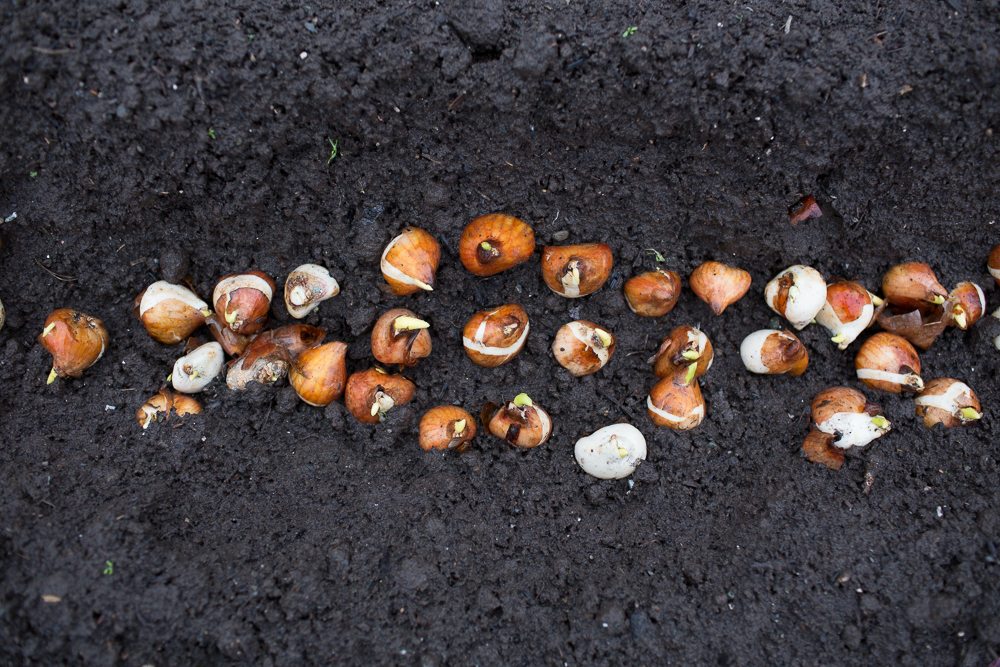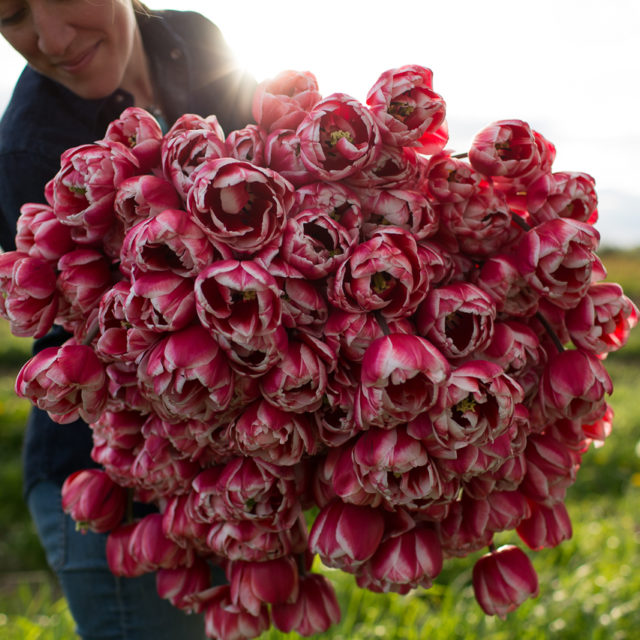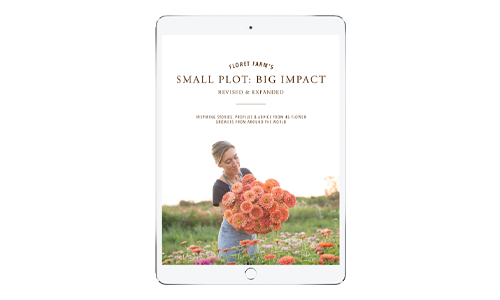Tulips are an incredibly diverse family of plants. Some have fringed petals, others have pointed ones, and some are so ruffled and full that they are commonly mistaken for peonies. Some varieties even carry a soft, subtle scent. With so many wonderful qualities, it’s no wonder that tulips are one of the most popular cut flowers on the market. Because they are one of the easiest spring bulbs you can grow, tulips are a mainstay in the spring cutting garden. Here at Floret we plant tens of thousands of them each year.
I love the double-flowered and parrot types, as I find the standard tulip shapes a bit boring. I am drawn to the exotic, unusual and showy types that really make a bouquet stand out.
I’m always on the lookout for tulips and other flower varieties that you can’t get just anywhere. This is particularly important given the fact that our little 2-acre farm is surrounded by plantation-sized tulip farms that mass-produce inexpensive common tulips. Even though Floret is a tiny fish in a big sea of flower growers in Skagit Valley, we have been able to compete and get better prices per stem because we grow tulips that are available earlier and are totally different than the kind available in the mass market.
Tulip Planting Tips for Gardeners
There are a few different methods for growing these showy spring bloomers, depending on whether you simply want to add color to your spring landscape or harvest them in abundance as cut flowers. No matter how you plant them, be sure to pick a spot that gets full sun and doesn’t have any standing water, since really wet soil will encourage disease and rot.
In the garden, tulips make the most impact when planted en masse. For a real show, I recommend ditching the bulb planter and plant bulbs in clusters of at least 10. Use a shovel to dig down and remove 6 inches of soil in the area where you plan to plant. Mix in a little organic bulb fertilizer and compost, and then plant your bulbs roughly three times as deep as they are tall. Tulips can be planted quite close, less than an inch from each other. Once your bulbs are securely in place, water deeply and then refill the hole with the soil you removed earlier. Add a few inches of well rotted compost on top to act as a mulch. Be sure to insert some type of stake so you remember where you planted them.
Tips for Flower Farmers
As a small-scale, high intensity flower farm, we approach tulip production differently than home gardeners and treat tulips as annuals. We plant thousands of tulips every year utilizing a technique that involves digging out long 3ft. wide, 6″ deep trenches. We set the bulbs in very close together, but not actually touching–sort of like eggs in an egg carton. This allows us to fit an enormous number of flowers in a very tiny space. We plant the majority of our tulips in our unheated hoop houses, followed by a smaller outdoor field planting. The tulips grown in the hoop house bloom nearly a month earlier than bulbs planted outdoors, extending our harvest window to nearly two full months.
Once the flowers start to bloom in the spring, we harvest the tulip–bulb and all– for maximum stem length, storage and vase life. That means we need to re-plant new bulbs each fall in order to have consistent high quality blooms. If the flower is harvested but the bulb is left in the ground, the tulip *may* bloom in subsequent years but it is typically of diminished quality, which unfortunately just doesn’t cut it for commercial production. Plus, since we have space constraints, we try to maximize every square foot of soil we have available.
Once our tulip harvest is complete in the spring, we clear the bed and prep the soil by adding organic fertilizer and a thick layer of compost. We then will transplant a new crop into that same bed, typically heat-loving tender annuals. Utilizing this high intensity technique enables us to produce two crops in the same bed over the course of the same growing season.
Tulip Harvesting & Care Tips
As the flowers start to push up through the soil in the spring, it’s important to keep the beds weeded and also start watering more regularly, if your area is dry.
For the longest vase life, harvest tulips before the flowers have fully opened, ideally just as the buds are just beginning to show color.
If you are a home gardener and want to perennialize your tulips, it’s important to leave at least two sets of leaves on the stem when harvesting in order to replenish the bulb and give it energy to bloom the following season. Just note that blooms may be of lesser quality in subsequent years.
Again, flower farmers typically pull the entire plant up bulb and all during harvest. Pulling bulbs is relatively easy in our sandy soil. Harvesting in heavier clay soils, however, may require the help of a shovel.
With the bulb attached, tulips can be stored dry for up to one month in the cooler, because they are still connected to their food source. We re-use bulb crates to store our tulips with bulbs attached and standing them upright in the cooler. When it’s time to use them, we cut off the bulb and place stems into water with flower food.
Tulips tend to curve a bit after harvest. To encourage upright stems, wrap the top two-thirds of the flower in a paper funnel and stand upright in water for a few hours.
Tulips have a naturally long vase life, and many varieties can last up to a week and a half. Adding flower preservative also furthers vase life.
Once fully hydrated, fresh-cut tulip stems continue to elongate for a few days, so if you’re making a bouquet or arrangement, be sure to tuck the flowers deeper into your design than seems necessary with this in mind.
Floret's Favorites
This spring, I conducted field trials on over three dozen tulip cultivars. I am always on the lookout for new (or new-to-me) flowers that grow well and that have great stem length and vase life. And if they come in uncommon colors, particularly the subtle hues coveted by floral designers, that is icing on the cake.
Here’s a roundup of my latest favorites:
Black Hero: This unique, fully double black variety is a sport of Queen of the Night. Its tall, strong stems and dark coloring make it an awesome addition to large scale, dramatic arrangements.
Charming Beauty: The name couldn’t be more true, this farm-fresh egg yolk yellow double flowered variety is an excellent addition to spring arrangements. It’s tricky to find good yellow blooms, and the soft, glowing petals of this unique variety make it a must-grow.
Drumline: Unique in coloring, this tulip reminds us of Christmastime and peppermint candies. Petals are deep red at the base, fading from rosy to ivory white at the tips. A showy choice ideal for cut flower arranging with a long vase life and tall, strong stems. A favorite with everyone who visits the farm in April.
Renown Unique: The very last variety to bloom in our garden, this peony flowered beauty is the top requested variety we grow. Each massive stem is topped with a fully ruffled, watermelon colored flower that is commonly mistaken for a peony. Be sure to harvest after the flowers have started to open, otherwise it won’t be as richly colored.
Santander: Like a vibrant pink teacup from Alice in Wonderland, this feminine tulip starts in the bud stage as peach-blush. As the fringe edged petals open and turn cotton candy pink, they reveal a blue throat and black anthers. Strong, long stems and large flower heads along with a uniform growth habit make this a winner for design work.
Professor Rontgen: The largest flowered parrot variety I’ve ever grown, this beast is a real show stopper. Fist sized buds open to huge, vivid tangerine-toned flowers that look amazing en mass or mixed into Dutch still life inspired bouquets. If you can only grow one parrot, make this one it!
A few other noteworthy favorites are Salmon Parrot and ‘Sensual Touch’. You can many of these favorites and more over in the Floret Shop.
Reader Favorites
What kinds of bulbs do you have in your garden? Any new ones you’re planting this year? I’d love to know about some of your favorites in the comments below.
Congratulations to blog commenters: Laura V., Missy G., kelcimcintosh, Lori M., and Heather for winning our Floret bulb giveaway!

















melissa on
Hi there Erin!
I followed all your guidelines about planting tulips and followed the breeders timeline for appropriate planting time but my foxy foxtrot bulbs are starting to bloom but are super short and super small. I’m in Colorado zone 5b. Do you have some ideas on why this may have happened? I’m so bummed!